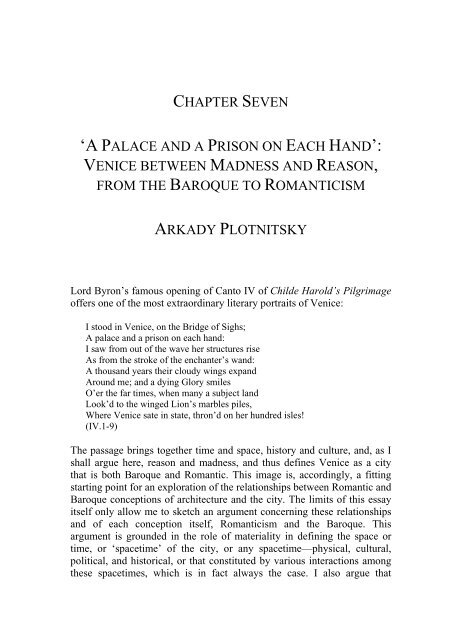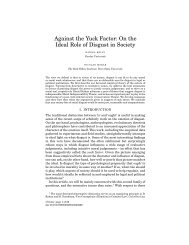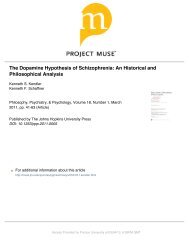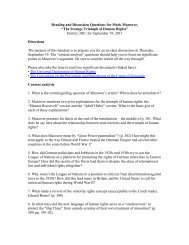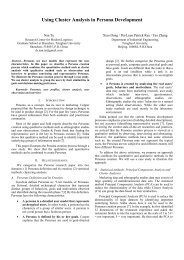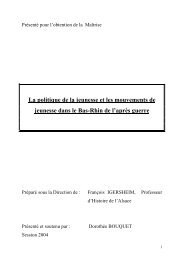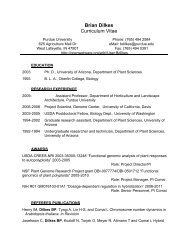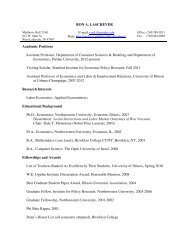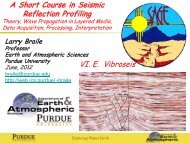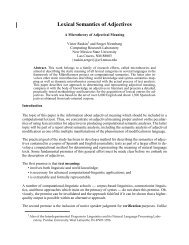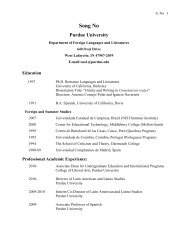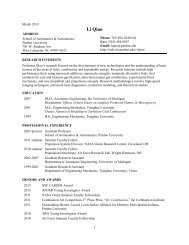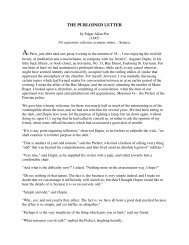'a palace and a prison on each hand': venice between madness and ...
'a palace and a prison on each hand': venice between madness and ...
'a palace and a prison on each hand': venice between madness and ...
Create successful ePaper yourself
Turn your PDF publications into a flip-book with our unique Google optimized e-Paper software.
CHAPTER SEVEN<br />
‘A PALACE AND A PRISON ON EACH HAND’:<br />
VENICE BETWEEN MADNESS AND REASON,<br />
FROM THE BAROQUE TO ROMANTICISM<br />
ARKADY PLOTNITSKY<br />
Lord Byr<strong>on</strong>’s famous opening of Canto IV of Childe Harold’s Pilgrimage<br />
offers <strong>on</strong>e of the most extraordinary literary portraits of Venice:<br />
I stood in Venice, <strong>on</strong> the Bridge of Sighs;<br />
A <str<strong>on</strong>g>palace</str<strong>on</strong>g> <str<strong>on</strong>g>and</str<strong>on</strong>g> a <str<strong>on</strong>g>pris<strong>on</strong></str<strong>on</strong>g> <strong>on</strong> <strong>each</strong> h<str<strong>on</strong>g>and</str<strong>on</strong>g>:<br />
I saw from out of the wave her structures rise<br />
As from the stroke of the enchanter’s w<str<strong>on</strong>g>and</str<strong>on</strong>g>:<br />
A thous<str<strong>on</strong>g>and</str<strong>on</strong>g> years their cloudy wings exp<str<strong>on</strong>g>and</str<strong>on</strong>g><br />
Around me; <str<strong>on</strong>g>and</str<strong>on</strong>g> a dying Glory smiles<br />
O’er the far times, when many a subject l<str<strong>on</strong>g>and</str<strong>on</strong>g><br />
Look’d to the winged Li<strong>on</strong>’s marbles piles,<br />
Where Venice sate in state, thr<strong>on</strong>’d <strong>on</strong> her hundred isles!<br />
(IV.1-9)<br />
The passage brings together time <str<strong>on</strong>g>and</str<strong>on</strong>g> space, history <str<strong>on</strong>g>and</str<strong>on</strong>g> culture, <str<strong>on</strong>g>and</str<strong>on</strong>g>, as I<br />
shall argue here, reas<strong>on</strong> <str<strong>on</strong>g>and</str<strong>on</strong>g> <strong>madness</strong>, <str<strong>on</strong>g>and</str<strong>on</strong>g> thus defines Venice as a city<br />
that is both Baroque <str<strong>on</strong>g>and</str<strong>on</strong>g> Romantic. This image is, accordingly, a fitting<br />
starting point for an explorati<strong>on</strong> of the relati<strong>on</strong>ships <strong>between</strong> Romantic <str<strong>on</strong>g>and</str<strong>on</strong>g><br />
Baroque c<strong>on</strong>cepti<strong>on</strong>s of architecture <str<strong>on</strong>g>and</str<strong>on</strong>g> the city. The limits of this essay<br />
itself <strong>on</strong>ly allow me to sketch an argument c<strong>on</strong>cerning these relati<strong>on</strong>ships<br />
<str<strong>on</strong>g>and</str<strong>on</strong>g> of <strong>each</strong> c<strong>on</strong>cepti<strong>on</strong> itself, Romanticism <str<strong>on</strong>g>and</str<strong>on</strong>g> the Baroque. This<br />
argument is grounded in the role of materiality in defining the space or<br />
time, or ‘spacetime’ of the city, or any spacetime—physical, cultural,<br />
political, <str<strong>on</strong>g>and</str<strong>on</strong>g> historical, or that c<strong>on</strong>stituted by various interacti<strong>on</strong>s am<strong>on</strong>g<br />
these spacetimes, which is in fact always the case. I also argue that
110<br />
Chapter Seven<br />
materiality itself must be c<strong>on</strong>ceived in the same plural (physical, cultural,<br />
political, <str<strong>on</strong>g>and</str<strong>on</strong>g> historical) <str<strong>on</strong>g>and</str<strong>on</strong>g> multiply interactive sense. My main thesis is<br />
that the materiality pertaining to a given space or spacetime inflects or<br />
‘curves’ this spacetime, as against the Euclidean <str<strong>on</strong>g>and</str<strong>on</strong>g> then Cartesian<br />
c<strong>on</strong>cepts of mathematical space, or our (Cartesian) models for other<br />
spaces, often based <strong>on</strong> these c<strong>on</strong>cepts.<br />
This statement is literally true in physics, where, according to Albert<br />
Einstein’s so-called general relativity theory, a n<strong>on</strong>-Newt<strong>on</strong>ian theory of<br />
gravity, introduced in 1915, the gravity of material bodies or of other<br />
forms of materiality, such as an electromagnetic field, curves spacetime<br />
(which physically means that gravity bends light rays). This curvature is,<br />
moreover, generally variable, depending <strong>on</strong> the amount of matter in the<br />
vicinity of a given point. The theory is grounded in <strong>on</strong>e of the key<br />
c<strong>on</strong>cepts of modern geometry, due to Bernhard Riemann, the c<strong>on</strong>cept of<br />
“manifold”—defined as (in general) a n<strong>on</strong>-Euclidean space, composed of a<br />
c<strong>on</strong>glomerate of local spaces, whose curvature may vary. The physical<br />
part of Einstein’s theory in part follows Leibniz, arguably the greatest<br />
philosopher of the Baroque. Leibniz questi<strong>on</strong>ed Newt<strong>on</strong>’s c<strong>on</strong>cept of<br />
absolute (ambient) space in which bodies are placed <str<strong>on</strong>g>and</str<strong>on</strong>g> argued instead<br />
that the idea of space is meaningless apart from the presence of physical<br />
bodies. The c<strong>on</strong>cept of spacetime was introduced earlier as part of thecalled<br />
special (rather than general) relativity theory, formulated by<br />
Einstein in 1905 <str<strong>on</strong>g>and</str<strong>on</strong>g> restricted to the theory of electromagnetic<br />
phenomena, such as light, in the absence of gravity. In either form of<br />
relativity theory, special or general, <strong>on</strong>e can no l<strong>on</strong>ger distinguish<br />
unc<strong>on</strong>diti<strong>on</strong>ally, <strong>on</strong>ce <str<strong>on</strong>g>and</str<strong>on</strong>g> for all, spatiality <str<strong>on</strong>g>and</str<strong>on</strong>g> temporality, since space<br />
can become time, <str<strong>on</strong>g>and</str<strong>on</strong>g> time space. By c<strong>on</strong>trast, the c<strong>on</strong>cept of spacetime is<br />
rigorously applicable throughout, <str<strong>on</strong>g>and</str<strong>on</strong>g> allows for this exchange <strong>between</strong><br />
spatial <str<strong>on</strong>g>and</str<strong>on</strong>g> temporal determinati<strong>on</strong>s of events depending <strong>on</strong> the frame of<br />
reference in which a given event is defined. The scheme is correlative to<br />
the impossibility of a single frame of reference that would allow <strong>on</strong>e to<br />
coordinate all the events in the way it is possible in Newt<strong>on</strong>’s physics.<br />
This impossibility gives the spacetimes of Einstein’s theory an irreducible<br />
heterogeneity, even in the absence of gravity. The variability of curvature,<br />
defined by gravity, gives spacetimes of general relativity an even more<br />
radical heterogeneity. Indeed, apart from certain special cases, it deprives<br />
them of all homogeneity, in accordance Riemann’s c<strong>on</strong>cept of manifold,<br />
defined as a heterogeneous, but c<strong>on</strong>nected, c<strong>on</strong>glomerate of local spaces<br />
(of, in general variable curvature) ‘quilted’ together.<br />
Einstein’s theory has important technological underpinnings in the<br />
processes of observati<strong>on</strong> <str<strong>on</strong>g>and</str<strong>on</strong>g> measurement, which give it a more complex
Venice <strong>between</strong> Madness <str<strong>on</strong>g>and</str<strong>on</strong>g> Reas<strong>on</strong>, from the Baroque to Romanticism 111<br />
architecture <str<strong>on</strong>g>and</str<strong>on</strong>g>/as a form of materiality. Einstein’s great initial insight<br />
was that space, or time, do not exist independently, for example <str<strong>on</strong>g>and</str<strong>on</strong>g> in<br />
particular, in the form of Newt<strong>on</strong>’s absolute space <str<strong>on</strong>g>and</str<strong>on</strong>g> time, but instead<br />
arise, as effects, from the technological nature of our measuring<br />
instruments, such as rods <str<strong>on</strong>g>and</str<strong>on</strong>g> clocks, <str<strong>on</strong>g>and</str<strong>on</strong>g> of our perceptual <str<strong>on</strong>g>and</str<strong>on</strong>g> c<strong>on</strong>ceptual<br />
interacti<strong>on</strong>s with these instruments (those of our bodies included). This<br />
techno-material efficacy of space <str<strong>on</strong>g>and</str<strong>on</strong>g> time, <str<strong>on</strong>g>and</str<strong>on</strong>g> of spacetime, is not unlike<br />
the efficacity of Derrida’s différance, that produces, as effects, multiple<br />
differences, proximities, <str<strong>on</strong>g>and</str<strong>on</strong>g> interacti<strong>on</strong>s <strong>between</strong> <str<strong>on</strong>g>and</str<strong>on</strong>g> am<strong>on</strong>g entities that<br />
in an un-dec<strong>on</strong>structed regime would be seen as unc<strong>on</strong>diti<strong>on</strong>ally separate<br />
or opposite (Plotnitsky 2002, 184-99). Derrida sees différance as the<br />
material efficacity of both spatiality <str<strong>on</strong>g>and</str<strong>on</strong>g> temporality, of the spatiality of<br />
space <str<strong>on</strong>g>and</str<strong>on</strong>g> the temporality of time, or sometimes, of the spatiality of time<br />
<str<strong>on</strong>g>and</str<strong>on</strong>g> the temporality of space (Derrida 1982, 13). Materiality is c<strong>on</strong>ceived<br />
here so as to include the materiality of writing, using the term ‘writing’ in<br />
Derrida’s extended sense, reciprocal with a certain radical idea of<br />
materiality, coupled to the idea of technology, via différance <str<strong>on</strong>g>and</str<strong>on</strong>g> other<br />
Derridean “neither terms nor c<strong>on</strong>cepts,” such as trace, supplement,<br />
disseminati<strong>on</strong>, <str<strong>on</strong>g>and</str<strong>on</strong>g> so forth. This broader view of materiality allows <strong>on</strong>e to<br />
extend Einstein’s technological argument c<strong>on</strong>cerning space <str<strong>on</strong>g>and</str<strong>on</strong>g> time just<br />
sketched to space <str<strong>on</strong>g>and</str<strong>on</strong>g> time, or spacetime, of all our cultural producti<strong>on</strong>,<br />
including that of our theories, such as Einstein’s relativity. All cultural<br />
artifacts, scientific theories included, become effects, products, of a<br />
material différantial dynamics, <str<strong>on</strong>g>and</str<strong>on</strong>g> thus are written in Derrida’s sense by<br />
means of technologies of culture (beginning with pens <str<strong>on</strong>g>and</str<strong>on</strong>g> pencils, but<br />
hardly ending with them).<br />
An analogous type of argument was developed in the c<strong>on</strong>structivist<br />
social studies of science, where, more recently, an uncritical view of social<br />
c<strong>on</strong>structivism as a single determining “technology” of such producti<strong>on</strong>s<br />
was reexamined as well, bringing the resulting c<strong>on</strong>structivist argument<br />
closer to that offered in this essay (for example, Latour 1999). I am,<br />
however, primarily c<strong>on</strong>cerned here with extending this argumentati<strong>on</strong><br />
bey<strong>on</strong>d science, to the Baroque <str<strong>on</strong>g>and</str<strong>on</strong>g> the Romantic urban spacetimes, as<br />
curved by materiality in its various forms, <str<strong>on</strong>g>and</str<strong>on</strong>g> their artistic <str<strong>on</strong>g>and</str<strong>on</strong>g> literature<br />
representati<strong>on</strong>s. The term ‘architecture’ may be given a new meaning from<br />
this perspective: it creates space, physical <str<strong>on</strong>g>and</str<strong>on</strong>g> cultural, including political,<br />
or time <str<strong>on</strong>g>and</str<strong>on</strong>g> history rather than is something that is put in space for the<br />
purposes of living or other reas<strong>on</strong>s, or even merely something that shapes<br />
or reshapes the space it is put in. One might, then, define architecture as<br />
this materiality, materiality that makes possible any space or time, material<br />
or mental, physical or historical, <str<strong>on</strong>g>and</str<strong>on</strong>g> that defines any specific spacetime,
112<br />
Chapter Seven<br />
by always creating <str<strong>on</strong>g>and</str<strong>on</strong>g> dislocating it, by dec<strong>on</strong>structing <str<strong>on</strong>g>and</str<strong>on</strong>g>, importantly,<br />
(re)delimiting (rather than eliminating) any spatio-temporality that we<br />
might assume to be stable or definitive.<br />
It must be kept in mind, however, that, as Derrida (1982) <str<strong>on</strong>g>and</str<strong>on</strong>g> Paul de<br />
Man (1996) argue, it is impossible to unequivocally dissociate or<br />
metaphysically isolate materiality, physical or cultural, from<br />
phenomenality. Any specific form of materiality is, in part, given to us by<br />
phenomenality, even though phenomenality, too, is the product of<br />
materiality, beginning, again, with that of our bodies. These reciprocal<br />
interrelati<strong>on</strong>ships are irreducible <str<strong>on</strong>g>and</str<strong>on</strong>g> are themselves part of the type of<br />
dynamics that Derrida pursues in terms of différance <str<strong>on</strong>g>and</str<strong>on</strong>g> writing, <str<strong>on</strong>g>and</str<strong>on</strong>g> de<br />
Man pursues in terms of allegory, <str<strong>on</strong>g>and</str<strong>on</strong>g> specifically Romantic allegory. This<br />
process is captured or allegorized by Byr<strong>on</strong>’s depicti<strong>on</strong> or, again,<br />
inscripti<strong>on</strong> of Venice, with which I began here. Byr<strong>on</strong>’s percepti<strong>on</strong> <str<strong>on</strong>g>and</str<strong>on</strong>g><br />
thinking give Venice its shape, create (al<strong>on</strong>g with the physical materiality<br />
of the city around him <str<strong>on</strong>g>and</str<strong>on</strong>g> via the technology of his body) Venice <str<strong>on</strong>g>and</str<strong>on</strong>g> its<br />
architecture (in the c<strong>on</strong>venti<strong>on</strong>al sense). Byr<strong>on</strong>’s positi<strong>on</strong>, as a poet <str<strong>on</strong>g>and</str<strong>on</strong>g> an<br />
exile, <strong>on</strong> a bridge <strong>between</strong> a <str<strong>on</strong>g>palace</str<strong>on</strong>g> <str<strong>on</strong>g>and</str<strong>on</strong>g> <str<strong>on</strong>g>pris<strong>on</strong></str<strong>on</strong>g>, the positi<strong>on</strong> that defines<br />
poetry <str<strong>on</strong>g>and</str<strong>on</strong>g> the poet, is reciprocally defined by architectural materialities,<br />
physical, cultural, political, including those of Venice. Shelley thematizes<br />
the situati<strong>on</strong> is his descripti<strong>on</strong> of “[his] own, [his] human mind . . . /<br />
Holding an unremitting interchange/ With clear universe of things around”<br />
in “M<strong>on</strong>t Blanc” (36-40), which depicts the mountain in architectural <str<strong>on</strong>g>and</str<strong>on</strong>g><br />
often Baroque terms of “city” <str<strong>on</strong>g>and</str<strong>on</strong>g> “ruin”.<br />
By endowing a given spacetime curvature, <str<strong>on</strong>g>and</str<strong>on</strong>g>, to begin with, by<br />
merging space <str<strong>on</strong>g>and</str<strong>on</strong>g> time into a heterogeneous spacetime (<str<strong>on</strong>g>and</str<strong>on</strong>g>, by<br />
extensi<strong>on</strong>, culture <str<strong>on</strong>g>and</str<strong>on</strong>g> history into a manifold of cultural-historical<br />
chr<strong>on</strong>otopes, as Mikhail Bakhtin would call them), materiality, I argue,<br />
also gives it a “Baroque” architecture, as against a Euclidean or Cartesian<br />
<strong>on</strong>e. This curving <str<strong>on</strong>g>and</str<strong>on</strong>g> especially varying curving of chr<strong>on</strong>otopes by<br />
materiality <str<strong>on</strong>g>and</str<strong>on</strong>g> specifically by Derridean or de Manian techno-materiality<br />
appears to be missed by Bakhtin, <str<strong>on</strong>g>and</str<strong>on</strong>g> I would argue, by Henri Lefebvre’s<br />
analysis of urban spacetimes (sometimes also shifted or curved too much<br />
toward social c<strong>on</strong>structivism <str<strong>on</strong>g>and</str<strong>on</strong>g> away from more complex <str<strong>on</strong>g>and</str<strong>on</strong>g><br />
multilayered materialities). I use the term ‘Baroque’ both in its historical<br />
sense <str<strong>on</strong>g>and</str<strong>on</strong>g> in its c<strong>on</strong>ceptual sense, in part following Deleuze’s c<strong>on</strong>cept of<br />
the Baroque as elaborated in The Fold: Leibniz <str<strong>on</strong>g>and</str<strong>on</strong>g> the Baroque (Deleuze<br />
1992). This sense allows <strong>on</strong>e to extend the denominati<strong>on</strong> ‘Baroque’<br />
bey<strong>on</strong>d its c<strong>on</strong>venti<strong>on</strong>al historical boundaries, all the way into our own<br />
time, without in any way diminishing the significance of the historical<br />
Baroque; <str<strong>on</strong>g>and</str<strong>on</strong>g> Romanticism, I argue here, is part of this, still c<strong>on</strong>tinuing,
Venice <strong>between</strong> Madness <str<strong>on</strong>g>and</str<strong>on</strong>g> Reas<strong>on</strong>, from the Baroque to Romanticism 113<br />
history of the Baroque. (The historical Baroque retains its significance in<br />
shaping this history.) As noted above, in physics the idea of materiality, as<br />
defining the “architecture” of space, originates in Leibniz <str<strong>on</strong>g>and</str<strong>on</strong>g>, thus, in the<br />
Baroque, in Leibniz’s <str<strong>on</strong>g>and</str<strong>on</strong>g> the Baroque’s c<strong>on</strong>fr<strong>on</strong>tati<strong>on</strong> with Newt<strong>on</strong> <str<strong>on</strong>g>and</str<strong>on</strong>g><br />
the Cartesianism of Renaissance. As Boromini’s or Christopher Wren’s<br />
work especially dem<strong>on</strong>strates, the actual Baroque architecture explores<br />
both effects of materiality, spatio-temporality <str<strong>on</strong>g>and</str<strong>on</strong>g> curvature, at various<br />
levels—c<strong>on</strong>ceptual, physical, <str<strong>on</strong>g>and</str<strong>on</strong>g> cultural, including political. So do the<br />
Venetian Baroque painters, especially Tintoretto, who has a particular<br />
significance for Deleuze’s analysis of the Baroque (Deleuze 1992, 29-31;<br />
75).<br />
Thus understood, the Baroque frees its spacetimes from the impositi<strong>on</strong><br />
of the ‘Cartesian’ or (to the degree <strong>on</strong>e can still use the term)<br />
‘Renaissance’ architecture (mathematical, physical, or cultural) up<strong>on</strong> them<br />
(Deleuze 1992, 3; 32). This impositi<strong>on</strong> would presumably enable a<br />
rati<strong>on</strong>al coordinati<strong>on</strong> of points or events in space or time, or spacetime<br />
(which may also be c<strong>on</strong>ceived, at least culturally, in these Cartesian<br />
terms). Ultimately, <strong>on</strong>e would be able to arrive at a single global<br />
coordinati<strong>on</strong> of all events in space <str<strong>on</strong>g>and</str<strong>on</strong>g> time. The Renaissance c<strong>on</strong>cept of<br />
perspective, grounded in Euclidean geometry <str<strong>on</strong>g>and</str<strong>on</strong>g> grounding the<br />
corresp<strong>on</strong>ding view of the world, Descartes’s analytic geometry (which<br />
algebraically codifies geometrical lines <str<strong>on</strong>g>and</str<strong>on</strong>g> figures), <str<strong>on</strong>g>and</str<strong>on</strong>g> Newt<strong>on</strong>’s<br />
absolute space <str<strong>on</strong>g>and</str<strong>on</strong>g> absolute time are am<strong>on</strong>g the primary models of this<br />
philosophy <str<strong>on</strong>g>and</str<strong>on</strong>g> ideology based <strong>on</strong> it. This ideology has its proper material<br />
efficacity in the c<strong>on</strong>comitant development of capitalism <str<strong>on</strong>g>and</str<strong>on</strong>g>, in Louis<br />
Althusser’s language, its ideological state apparatuses. By c<strong>on</strong>trast, while<br />
Baroque spaces, or, their best mathematical model, Riemannian spaces in<br />
mathematics, allow for local coordinati<strong>on</strong> <str<strong>on</strong>g>and</str<strong>on</strong>g> grids (it may not be possible<br />
to do without them), they do not in general allow for global coordinati<strong>on</strong>.<br />
The cities were gradually made to c<strong>on</strong>form to or to obey more <str<strong>on</strong>g>and</str<strong>on</strong>g><br />
more this Cartesian rati<strong>on</strong>ality <str<strong>on</strong>g>and</str<strong>on</strong>g> coordinati<strong>on</strong>, spatial or cultural, or<br />
historical, insofar as their past history was ‘revised’, <str<strong>on</strong>g>and</str<strong>on</strong>g> their future<br />
would be shaped accordingly. Of course, coordinati<strong>on</strong> <str<strong>on</strong>g>and</str<strong>on</strong>g> grids, spatial<br />
<str<strong>on</strong>g>and</str<strong>on</strong>g> cultural, have existed in <str<strong>on</strong>g>and</str<strong>on</strong>g> shaped cities <str<strong>on</strong>g>and</str<strong>on</strong>g> other spaces throughout<br />
human history. In questi<strong>on</strong> here is a broad ideology <str<strong>on</strong>g>and</str<strong>on</strong>g> its material<br />
apparatuses aimed at a global (rati<strong>on</strong>al) cultural-historical coordinati<strong>on</strong><br />
that defined the city <str<strong>on</strong>g>and</str<strong>on</strong>g>, al<strong>on</strong>g with the life of society, the city life,<br />
accordingly. This ideology was also to serve the program of the<br />
Enlightenment <str<strong>on</strong>g>and</str<strong>on</strong>g> was, reciprocally, amplified <str<strong>on</strong>g>and</str<strong>on</strong>g>, in practice, enforced<br />
by this program.
114<br />
Chapter Seven<br />
The program proved to be more difficult to advance in some cases,<br />
such as Venice, many political pressures, from within <str<strong>on</strong>g>and</str<strong>on</strong>g> from without,<br />
notwithst<str<strong>on</strong>g>and</str<strong>on</strong>g>ing. Some of these pressures unavoidably had their effects,<br />
which resulted in losses in the Baroque richness of Venice’s spacetimes,<br />
lamented by Byr<strong>on</strong> in Childe Harold. Still, Venice has managed to remain<br />
more Baroque in its spacetimes under the Cartesian siege of the<br />
Enlightenment, <str<strong>on</strong>g>and</str<strong>on</strong>g> even absorb Cartesianism into them. Venice is a<br />
Baroque city par excellence, not <strong>on</strong>ly in terms of the architecture of its<br />
buildings or its paintings, but also in terms of its overall curvilinear<br />
Baroque spacetime, physical, cultural, <str<strong>on</strong>g>and</str<strong>on</strong>g> historical. Indeed, <strong>on</strong>e can<br />
hardly doubt that this spacetime helped to bring about its architecture <str<strong>on</strong>g>and</str<strong>on</strong>g><br />
especially paintings.<br />
Also a mad city, literally a mind twisting city, <str<strong>on</strong>g>and</str<strong>on</strong>g> a (the?) city of<br />
<strong>madness</strong>! This aspect of Venice is symbolized or allegorized arguably<br />
most dramatically or tragically by its greatest im<str<strong>on</strong>g>pris<strong>on</strong></str<strong>on</strong>g>ed mad man <str<strong>on</strong>g>and</str<strong>on</strong>g> its<br />
greatest poet, Torquato Tasso. Tasso, described as “the Bard” mad <str<strong>on</strong>g>and</str<strong>on</strong>g><br />
“divine” (echoing Plato’s definiti<strong>on</strong> of poetry as divine <strong>madness</strong> in I<strong>on</strong>), is<br />
the first proper name menti<strong>on</strong> by Byr<strong>on</strong>, <str<strong>on</strong>g>and</str<strong>on</strong>g> it figures significantly in the<br />
part of Canto IV devoted to Venice (Childe Harold, IV, 146; 19). Tasso’s<br />
story, as a story of love, politics, <str<strong>on</strong>g>and</str<strong>on</strong>g> <strong>madness</strong>, becomes central to<br />
Shelley’s Julian <str<strong>on</strong>g>and</str<strong>on</strong>g> Maddalo, in part inspired by his reading of the Canto.<br />
With Michel Foucault’s analysis of <strong>madness</strong> in the classical age, the<br />
age of Cartesian reas<strong>on</strong>, I give (with due cauti<strong>on</strong>) the idea of the Baroque<br />
city as a “mad city” a positive meaning. For, <strong>on</strong>e might say that this<br />
Baroque architecture or the Baroque more generally gives or restores a<br />
certain form of ‘<strong>madness</strong>’ to our spacetimes. Indeed, <strong>on</strong>e could, at least<br />
metaphorically <str<strong>on</strong>g>and</str<strong>on</strong>g> perhaps not <strong>on</strong>ly metaphorically (since lines are<br />
created by us rather than exist as pre-given in some pre-given space,<br />
material or mental), define curvature as a certain <strong>madness</strong>, perhaps the<br />
divine <strong>madness</strong>, of the straight line, as a straight line g<strong>on</strong>e astray, as if<br />
deflected, sometimes traumatically, by something within or without it.<br />
Unless, it is, <strong>on</strong> the c<strong>on</strong>trary, the straight line that is a mad curve, <str<strong>on</strong>g>and</str<strong>on</strong>g><br />
Cartesian coordinati<strong>on</strong> <str<strong>on</strong>g>and</str<strong>on</strong>g> reas<strong>on</strong> are <strong>madness</strong>—not reas<strong>on</strong> g<strong>on</strong>e mad, but<br />
the <strong>madness</strong> of reas<strong>on</strong> itself. Descartes perhaps already knew this, even if<br />
against himself, as Derrida argues in his reading of Foucault, which may<br />
be more Foucauldian that it might appear (Derrida 1978). It follows that<br />
<strong>madness</strong> <str<strong>on</strong>g>and</str<strong>on</strong>g> reas<strong>on</strong>, even in mathematics, let al<strong>on</strong>e in poetry, are not<br />
simply or unequivocally distinguishable so as to allow reas<strong>on</strong> to isolate<br />
<strong>madness</strong>, just as Venice or its rulers wanted to isolate Tasso or Paris<br />
Ant<strong>on</strong>in Artaud. Artaud, al<strong>on</strong>gside Vincent van Gogh <str<strong>on</strong>g>and</str<strong>on</strong>g> Friedrich<br />
Nietzsche, is Foucault’s principal example of <strong>madness</strong> judging reas<strong>on</strong>,
Venice <strong>between</strong> Madness <str<strong>on</strong>g>and</str<strong>on</strong>g> Reas<strong>on</strong>, from the Baroque to Romanticism 115<br />
defined, naïvely, as the grid of the rati<strong>on</strong>al. But then, Foucault’s point is<br />
that these cases, or, by implicati<strong>on</strong>, that of Tasso, are not essentially<br />
different from most other cases of <strong>madness</strong>, which reas<strong>on</strong> or, again,<br />
something that sees itself as reas<strong>on</strong> wants to isolate. As will be seen,<br />
Shelley makes the same point in Julian <str<strong>on</strong>g>and</str<strong>on</strong>g> Maddalo. This is why<br />
Foucault argues that <strong>each</strong> of these cases or any case of <strong>madness</strong>, or reas<strong>on</strong>,<br />
is both exemplary <str<strong>on</strong>g>and</str<strong>on</strong>g> yet unique in its mixture of reas<strong>on</strong> <str<strong>on</strong>g>and</str<strong>on</strong>g> <strong>madness</strong>. In<br />
Baroque spacetimes, boundaries <strong>between</strong> reas<strong>on</strong> <str<strong>on</strong>g>and</str<strong>on</strong>g> <strong>madness</strong> are possible,<br />
too, <str<strong>on</strong>g>and</str<strong>on</strong>g> sometimes necessary, but are never unc<strong>on</strong>diti<strong>on</strong>al or established<br />
<strong>on</strong>ce <str<strong>on</strong>g>and</str<strong>on</strong>g> for all. These spaces combine reas<strong>on</strong>s <str<strong>on</strong>g>and</str<strong>on</strong>g> <strong>madness</strong> (as the best<br />
reas<strong>on</strong> or <strong>madness</strong> must do), just as Riemannian spaces in mathematics<br />
<str<strong>on</strong>g>and</str<strong>on</strong>g> Einsteinian spaces in physics combine Cartesian grids or other<br />
coordinati<strong>on</strong> with the play of curvatures.<br />
Venetian paintings offer remarkable allegories of the architectural<br />
materiality of the Baroque in the present sense, that of inflecting <str<strong>on</strong>g>and</str<strong>on</strong>g><br />
curving spacetimes, interactively, physical, phenomenal, <str<strong>on</strong>g>and</str<strong>on</strong>g> cultural—<br />
from straight lines to curves, from coordinati<strong>on</strong> <str<strong>on</strong>g>and</str<strong>on</strong>g> grids to curved spaces<br />
with at most local coordinati<strong>on</strong>, from reas<strong>on</strong> to <strong>madness</strong>. Tintoretto’s<br />
paintings are perhaps the greatest examples of this allegorizati<strong>on</strong> <str<strong>on</strong>g>and</str<strong>on</strong>g>, thus,<br />
of the Baroque in Deleuze’s extended sense, <str<strong>on</strong>g>and</str<strong>on</strong>g>, as I said, they are<br />
important for Deleuze’s analysis of the Baroque. In Tintoretto’s frescoes<br />
of the Scuola di San Rocco, virtually all spaces or temporalities, physical<br />
<str<strong>on</strong>g>and</str<strong>on</strong>g> social, are defined by the material, corporeal (‘heavy’) bodies,<br />
architectural or human, <str<strong>on</strong>g>and</str<strong>on</strong>g> by their movement from the physical<br />
architecture <str<strong>on</strong>g>and</str<strong>on</strong>g> material architectural creati<strong>on</strong> of spacetime in them, to the<br />
historical <str<strong>on</strong>g>and</str<strong>on</strong>g> social, including political, <strong>on</strong>es, <str<strong>on</strong>g>and</str<strong>on</strong>g> the corresp<strong>on</strong>ding<br />
spacetimes. As a result, they also become reflecti<strong>on</strong>s of, <str<strong>on</strong>g>and</str<strong>on</strong>g> <strong>on</strong>, the fact<br />
that Venice, beginning with its architecture, is indissociable from its<br />
politics <str<strong>on</strong>g>and</str<strong>on</strong>g> its geopolitics. More accurately, <strong>on</strong>e should speak of the<br />
interplay of both. One need not start with physical spacetimes <str<strong>on</strong>g>and</str<strong>on</strong>g> then<br />
move to the historical <str<strong>on</strong>g>and</str<strong>on</strong>g> social-political <strong>on</strong>es, although the physical <strong>on</strong>es<br />
might strike <strong>on</strong>e first in experiencing these paintings. Instead, both types<br />
of spacetimes incessantly, interminably pass into <str<strong>on</strong>g>and</str<strong>on</strong>g> define <strong>each</strong> other,<br />
often through the interacti<strong>on</strong>s, c<strong>on</strong>fr<strong>on</strong>tati<strong>on</strong>al or c<strong>on</strong>s<strong>on</strong>ant, of the<br />
different perspectives <strong>on</strong> the world offered by their characters.<br />
A significant porti<strong>on</strong> of Romantic poetry, especially that of the<br />
younger Romantics, such as Byr<strong>on</strong>, Shelley, <str<strong>on</strong>g>and</str<strong>on</strong>g> Keats, or their German<br />
counterparts, such as Heinrich v<strong>on</strong> Kleist (Deleuze 1992, 125), is<br />
c<strong>on</strong>cerned with <str<strong>on</strong>g>and</str<strong>on</strong>g> offers allegories of the Baroque. It explores the<br />
emergence of curved, as against Cartesian or Newt<strong>on</strong>ian, spacetimes due<br />
to the acti<strong>on</strong> of materiality up<strong>on</strong> them, with both these spacetimes <str<strong>on</strong>g>and</str<strong>on</strong>g>
116<br />
Chapter Seven<br />
materiality defined broadly as phenomenal, physical, <str<strong>on</strong>g>and</str<strong>on</strong>g> cultural, or<br />
interactively all three. Specific references to Baroque architecture <str<strong>on</strong>g>and</str<strong>on</strong>g><br />
cities, in particular, Venice or Rome, in Byr<strong>on</strong>’s Childe Harold or in<br />
Shelley’s Ad<strong>on</strong>ais <str<strong>on</strong>g>and</str<strong>on</strong>g> Julian <str<strong>on</strong>g>and</str<strong>on</strong>g> Maddalo, are both symptomatic of the<br />
significance of these allegories <str<strong>on</strong>g>and</str<strong>on</strong>g> help to create them. It is worth citing<br />
Shelley’s letter, written from Milan after a visit to Como, which he<br />
describes in terms of a “uni<strong>on</strong> of culture <str<strong>on</strong>g>and</str<strong>on</strong>g> the untamable profusi<strong>on</strong> &<br />
loveliness of nature is here so close that the line where they are divided<br />
can hardly be discovered”. He then writes:<br />
Como is <strong>on</strong>ly 6 leagues from Milan, & its mountains are seen from the<br />
Cathedral. This Cathedral is a most ast<strong>on</strong>ishing work of art. It’s built of<br />
white marble & cut into pinnacles of immense height & the utmost<br />
delicacy <str<strong>on</strong>g>and</str<strong>on</strong>g> workmanship, & loaded with sculpture. The effect of it,<br />
piercing the solid blue with those groups of dazzling spires relieved by the<br />
serene depth of this Italian heaven, or by mo<strong>on</strong>light when the stars seem<br />
gathered am<strong>on</strong>g those sculpture shapes is bey<strong>on</strong>d anything I had imagined<br />
architecture is capable of producing. The interior tho[ugh] very sublime is<br />
of a more earthly character, & with its stained glass & massy granite<br />
columns overloaded with antique figures & the silver lamps that burn<br />
forever under the canopy of black cloth beside the brazen altar & <str<strong>on</strong>g>and</str<strong>on</strong>g> the<br />
marble fretwork of the dome, give it the aspect of some gorgeous<br />
sepulchre. There is <strong>on</strong>e solitary spot am<strong>on</strong>g these aisles behind the altar<br />
where the light of the day is dim & yellow under the storied window which<br />
I have chosen to visit & to read Dante there.<br />
I have devoted the summer & indeed the next year to the compositi<strong>on</strong><br />
of a tragedy <strong>on</strong> the subject of Tasso’s <strong>madness</strong>, which I find up<strong>on</strong><br />
inspecti<strong>on</strong> is, if properly treated, admirably dramatic & poetical. (Shelley<br />
1964, 2; 461-62)<br />
The phrase “architecture is capable of producing” may be read in the<br />
direct sense, at work through Shelley’s depicti<strong>on</strong> of architecture in his<br />
poetry. Architecture produces a curved Baroque spacetime in which<br />
Shelley finds himself, <str<strong>on</strong>g>and</str<strong>on</strong>g> which his own phenomenal percepti<strong>on</strong> <str<strong>on</strong>g>and</str<strong>on</strong>g><br />
thinking help to c<strong>on</strong>struct as such in a reciprocal interchange with the<br />
architectural universe around him. The tragedy <strong>on</strong> the subject of Tasso’s<br />
<strong>madness</strong>, a quintessentially Baroque subject, linked to the curved, mindtwisting<br />
spaces of the Baroque Venice, never materialized. The project<br />
mutated into Julian <str<strong>on</strong>g>and</str<strong>on</strong>g> Maddalo, perhaps a fortunate genetic mutati<strong>on</strong>.<br />
While keeping the same spacetime of the Baroque <str<strong>on</strong>g>and</str<strong>on</strong>g> the same city,<br />
Venice, as its primary incarnati<strong>on</strong> (also in the direct sense of material<br />
embodiment), the poem replaced or rather linked both poetry <str<strong>on</strong>g>and</str<strong>on</strong>g> the<br />
<strong>madness</strong> of Tasso to, as Shelley says in his Preface, the “ag<strong>on</strong>y” found in
Venice <strong>between</strong> Madness <str<strong>on</strong>g>and</str<strong>on</strong>g> Reas<strong>on</strong>, from the Baroque to Romanticism 117<br />
“the text of every heart” (Shelley 1977, 113). It is not be possible for me to<br />
give a proper reading of this extraordinary work. Nearly every line of the<br />
poem, by the very nature of the dynamic flow of its poetic curvature<br />
(characteristic of Shelley’s poetry in general), inscribes, enacts both the<br />
Baroque in the broad sense of this paper <str<strong>on</strong>g>and</str<strong>on</strong>g> the Baroque of Venice. I<br />
would like, however, to comment <strong>on</strong> the questi<strong>on</strong> of <strong>madness</strong> in the poem<br />
from this perspective.<br />
Inspired by the story of Tasso <str<strong>on</strong>g>and</str<strong>on</strong>g> by Shelley’s reading of Canto IV of<br />
Byr<strong>on</strong>’s Childe Harold, the poem is structured as a “c<strong>on</strong>versati<strong>on</strong>” (the<br />
poem’s subtitle) <strong>between</strong> its two main protag<strong>on</strong>ists, Julian <str<strong>on</strong>g>and</str<strong>on</strong>g> Maddalo.<br />
The poem ostensibly suggests Shelley as a prototype for Julian <str<strong>on</strong>g>and</str<strong>on</strong>g> Byr<strong>on</strong><br />
for Maddalo, <str<strong>on</strong>g>and</str<strong>on</strong>g> gives the corresp<strong>on</strong>ding character a few traits of <strong>each</strong><br />
poet. As, however, a number of commentaries, beginning with Earl<br />
Wasserman’s classic study (Wasserman 1971, 57-83), show, the poem<br />
makes it both difficult <str<strong>on</strong>g>and</str<strong>on</strong>g> unnecessary to identify or even to properly<br />
correlate the two protag<strong>on</strong>ists with Shelley <str<strong>on</strong>g>and</str<strong>on</strong>g> Byr<strong>on</strong> respectively. The<br />
c<strong>on</strong>versati<strong>on</strong> is a c<strong>on</strong>fr<strong>on</strong>tati<strong>on</strong> <strong>between</strong> Julian’s (roughly Enlightenment)<br />
views, explained in detail throughout the poem, <str<strong>on</strong>g>and</str<strong>on</strong>g> “the darker side” (49)<br />
taken by Maddalo, whose specific views, however, are “not exactly<br />
known” (Shelley1977, 113). The case of the Maniac, the third main<br />
protag<strong>on</strong>ist (whose name is not given) of the poem, the case of <strong>madness</strong>,<br />
offers an occasi<strong>on</strong> to settle the dispute. The reas<strong>on</strong>s for the Maniac’s<br />
illness are not exactly known, <str<strong>on</strong>g>and</str<strong>on</strong>g>, as I shall explain, may ultimately not<br />
be important, although his disappointment in love appears to be the cause.<br />
The poem also c<strong>on</strong>tains two female characters—the Lady, the Maniac’s<br />
compani<strong>on</strong>, <str<strong>on</strong>g>and</str<strong>on</strong>g> Maddalo’s daughter—who are not given much space but<br />
whose significance is c<strong>on</strong>siderable, although their role cannot be<br />
c<strong>on</strong>sidered here.<br />
The debate remains unresolved, which is not surprising given the<br />
generally skeptical nature of Shelley’s poetry. Instead, as is characteristic<br />
of Shelley, more profound questi<strong>on</strong>s are posed, giving the two<br />
protag<strong>on</strong>ists <str<strong>on</strong>g>and</str<strong>on</strong>g> the poem’s reader an opportunity to think more deeply<br />
about the case <str<strong>on</strong>g>and</str<strong>on</strong>g> the world. Also, there emerges a new space or, again,<br />
spacetime of the relati<strong>on</strong>ships <strong>between</strong> people, a new spacetime of<br />
friendship (the words “friend” <str<strong>on</strong>g>and</str<strong>on</strong>g> “friendship” appear throughout the<br />
poem, <str<strong>on</strong>g>and</str<strong>on</strong>g> dominate the closing part, after an encounter with the Maniac),<br />
although I can <strong>on</strong>ly menti<strong>on</strong> this aspect of the poem here. The character of<br />
Maddalo’s daughter—”A woman, such as it has been my [Julian’s] doom<br />
[fate] / To meet with few, a w<strong>on</strong>der of this earth, / Where there is little of<br />
transcendent worth, / Like of Shakespeare’s women: kindly she / And with<br />
a manner bey<strong>on</strong>d courtesy/ Received her father’s friend (589-94)—
118<br />
Chapter Seven<br />
becomes especially significant in this c<strong>on</strong>text. In any event, Shelley’s<br />
strategy is to refocus <strong>on</strong> the l<strong>on</strong>g, disc<strong>on</strong>nected m<strong>on</strong>ologue of the Maniac,<br />
or rather partly disc<strong>on</strong>nected, <strong>between</strong> reas<strong>on</strong> <str<strong>on</strong>g>and</str<strong>on</strong>g> <strong>madness</strong>, which is often<br />
the language of what reas<strong>on</strong> sees as <strong>madness</strong>: “The colours of his mind<br />
seem yet unworn;/ For the wild language of his grief was high,/Such as in<br />
measure were called poetry” (ll. 540-542). One might say, with Foucault,<br />
that this is the voice of <strong>madness</strong>, which, however, also measures our<br />
reas<strong>on</strong>, especially that part of reas<strong>on</strong>s (or a form of <strong>madness</strong> in its own<br />
right, a dangerous form of <strong>madness</strong>), which defines <strong>madness</strong> as that which<br />
is outside the coordinates (the Cartesian space) of reas<strong>on</strong>. Equally subtle is<br />
Shelley’s rearranging of the architecture of the space that the Maniac<br />
inhabits. In resp<strong>on</strong>ding to Julian’s questi<strong>on</strong>: “Alas, what drove him mad?”,<br />
Maddalo replies:<br />
I cannot say;<br />
A Lady came with him from France, <str<strong>on</strong>g>and</str<strong>on</strong>g> when<br />
She left him <str<strong>on</strong>g>and</str<strong>on</strong>g> returned, he w<str<strong>on</strong>g>and</str<strong>on</strong>g>ered then<br />
About y<strong>on</strong> l<strong>on</strong>ely isles of desert s<str<strong>on</strong>g>and</str<strong>on</strong>g><br />
Till he grew wild—he had no cash or l<str<strong>on</strong>g>and</str<strong>on</strong>g><br />
Remaining—the police had brought him here—<br />
Some fancy took him <str<strong>on</strong>g>and</str<strong>on</strong>g> he would not bear<br />
Removal; so I fitted up for him<br />
Those rooms beside the sea, to please his whim,<br />
And sent him busts <str<strong>on</strong>g>and</str<strong>on</strong>g> books <str<strong>on</strong>g>and</str<strong>on</strong>g> urns for flowers,<br />
Which had adorned his life in happier hours,<br />
And instruments of music—you may guess<br />
A stranger could do little more or less<br />
For <strong>on</strong>e so gentle <str<strong>on</strong>g>and</str<strong>on</strong>g> unfortunate;<br />
And those are his sweet strains which charm the weight<br />
From madmen’s chains, <str<strong>on</strong>g>and</str<strong>on</strong>g> make this Hell appear<br />
A heaven of sacred silence, hushed to hear.—<br />
(245-61)<br />
The allusi<strong>on</strong> to Milt<strong>on</strong>’s “The mind is its own place, <str<strong>on</strong>g>and</str<strong>on</strong>g> in itself/ Can<br />
make a heav’n of hell, hell of heav’n” (Paradise Lost I, 254-55) is<br />
extraordinary <str<strong>on</strong>g>and</str<strong>on</strong>g> remarkably to the point, which c<strong>on</strong>tributes to its<br />
extraordinary impact. Heaven <str<strong>on</strong>g>and</str<strong>on</strong>g> Hell are both cities, <str<strong>on</strong>g>and</str<strong>on</strong>g> Venice may be<br />
both, just as was Dante’s Florence. The police, part of the surveillance<br />
system of the city <str<strong>on</strong>g>and</str<strong>on</strong>g> of the maintenance of its coordinated order <str<strong>on</strong>g>and</str<strong>on</strong>g><br />
social grid, bring the Maniac into his proper place of isolati<strong>on</strong>. The<br />
Maniac’s “fancy” not to be removed from his isolati<strong>on</strong> is an interesting<br />
questi<strong>on</strong> in its own right, but would require a separate c<strong>on</strong>siderati<strong>on</strong>. The<br />
main point here is that Maddalo creates a different spacetime, Leibniz
Venice <strong>between</strong> Madness <str<strong>on</strong>g>and</str<strong>on</strong>g> Reas<strong>on</strong>, from the Baroque to Romanticism 119<br />
would say, a different m<strong>on</strong>adological space or spacetime (the Maniac’s<br />
phenomenological time is yet another important subject, which I have to<br />
put aside here). This spacetime is the spacetime of the Baroque, now that<br />
of the Baroque interior, defined, as Deleuze argues, by the complex<br />
relati<strong>on</strong>ships <strong>between</strong> the pleats of matter <str<strong>on</strong>g>and</str<strong>on</strong>g> the fold of the souls, <str<strong>on</strong>g>and</str<strong>on</strong>g> of<br />
their respective curvatures (Deleuze 1992, 2-5). In this type of spacetime,<br />
the relati<strong>on</strong>ships <strong>between</strong> reas<strong>on</strong> <str<strong>on</strong>g>and</str<strong>on</strong>g> <strong>madness</strong> become radically redefined,<br />
preventing their unequivocal separati<strong>on</strong> <str<strong>on</strong>g>and</str<strong>on</strong>g> thus a rigorous (in either<br />
sense) isolati<strong>on</strong> of <strong>madness</strong> from reas<strong>on</strong>, its exclusi<strong>on</strong> from reas<strong>on</strong>. There<br />
are no police, governmental or mental, which can do so, without an abuse<br />
of power by the force that is supposed to protect us in reas<strong>on</strong> <str<strong>on</strong>g>and</str<strong>on</strong>g> <strong>madness</strong>.<br />
The spacetime of the Maniac’s room, or the spacetime of Venice, to which<br />
it is met<strong>on</strong>ymically related <str<strong>on</strong>g>and</str<strong>on</strong>g> which it, in part, metaphorically represents,<br />
is the allegory of these relati<strong>on</strong>ships.<br />
This is a gr<str<strong>on</strong>g>and</str<strong>on</strong>g> Foucauldian moment of the poem, which also allows<br />
us, with Shelley <str<strong>on</strong>g>and</str<strong>on</strong>g> Venice, to bring together Foucault <str<strong>on</strong>g>and</str<strong>on</strong>g> Deleuze<br />
(whose philosophical friendship is akin to that of Byr<strong>on</strong> <str<strong>on</strong>g>and</str<strong>on</strong>g> Shelley).<br />
From this perspective, the reas<strong>on</strong> for the Maniac’s <strong>madness</strong> is indeed less<br />
important than his voice, as Maddalo suggests to Julian earlier, before<br />
Julian’s Enlightenment ideas suffer a shipwreck in the Maniac’s room, in<br />
the spacetime of the Baroque, beside the sea, a space without grid, up<strong>on</strong><br />
which our navigati<strong>on</strong> likes to impose (albeit for good reas<strong>on</strong>s) coordinates.<br />
As Foucault tells us in The History of Madness (Foucault 1988; I use<br />
Foucault’s original title here), it is not <strong>on</strong>ly cases like those of van Gogh,<br />
Nietzsche, or Artaud that cannot be measured by reas<strong>on</strong>, if defined apart<br />
from <strong>madness</strong>, <str<strong>on</strong>g>and</str<strong>on</strong>g> that by their ‘<strong>madness</strong>’ measures this ‘reas<strong>on</strong>’ instead.<br />
Foucault appears to be using these cases because they make it difficult for<br />
us to separate reas<strong>on</strong> <str<strong>on</strong>g>and</str<strong>on</strong>g> <strong>madness</strong>. The main point or at least impact of<br />
appealing to them is, I would argue, in showing that every case of <strong>madness</strong><br />
would, given space enough <str<strong>on</strong>g>and</str<strong>on</strong>g> time, enough spacetime, reveal the same<br />
complexity of the relati<strong>on</strong>ships <strong>between</strong> reas<strong>on</strong> <str<strong>on</strong>g>and</str<strong>on</strong>g> <strong>madness</strong>.<br />
This is why Shelley gives no name to the Maniac <str<strong>on</strong>g>and</str<strong>on</strong>g> says in the<br />
Preface that “of the Maniac I [the ficti<strong>on</strong>al author of the preface] can give<br />
no informati<strong>on</strong>. He seems by his own account to have been disappointed in<br />
love.” Shelley suggests that “the unc<strong>on</strong>nected explanati<strong>on</strong> of his ag<strong>on</strong>y<br />
will perhaps be a sufficient comment for the text of every heart” (Shelley<br />
1977, 113). That his love story may be tragic, too tragic to be told <str<strong>on</strong>g>and</str<strong>on</strong>g><br />
made known to “the cold world,” which is also the world of cold reas<strong>on</strong>,<br />
as the poem’s last line tells us (l. 617), <strong>on</strong>ly supports <str<strong>on</strong>g>and</str<strong>on</strong>g> amplifies<br />
Shelley’s point. One need not be “officially” declared “mad” by reas<strong>on</strong> to<br />
be oppressed by it or to prove it wr<strong>on</strong>g when it tries to isolate <strong>madness</strong>
120<br />
Chapter Seven<br />
from thought. In the Maniac’s own words: “Me—who am as a nerve o’er<br />
which do creep/The else unfelt oppressi<strong>on</strong>s of this earth” (449-450;<br />
Shelley’s emphasis). If there is reas<strong>on</strong>, thinking reas<strong>on</strong>, <strong>madness</strong> is its<br />
nervous system. Our neural system is surely a supply system to both, just<br />
as canals are for Venice, <str<strong>on</strong>g>and</str<strong>on</strong>g> for its reas<strong>on</strong> <str<strong>on</strong>g>and</str<strong>on</strong>g> its <strong>madness</strong>.<br />
Works Cited<br />
Deleuze, Gilles. 1992. The Fold: Leibniz <str<strong>on</strong>g>and</str<strong>on</strong>g> the Baroque. trans. Tom<br />
C<strong>on</strong>ley. Minneapolis: University of Minnesota Press.<br />
De Man, Paul. 1996. Phenomenality <str<strong>on</strong>g>and</str<strong>on</strong>g> Materiality in Kant. Aesthetic<br />
Ideology. Minneapolis: University of Minnesota Press. 70-90.<br />
Derrida, Jacques. 1978. ‘Cogito <str<strong>on</strong>g>and</str<strong>on</strong>g> the History of Madness.’ Writing <str<strong>on</strong>g>and</str<strong>on</strong>g><br />
Difference. trans. Alan Bass. Chicago: University of Chicago Press.<br />
31-63.<br />
—. 1982. ‘Différance,’ Margins of Philosophy. trans. Alan Bass. Chicago:<br />
University of Chicago Press.<br />
Foucault, Michel. 1988. Madness <str<strong>on</strong>g>and</str<strong>on</strong>g> Civilizati<strong>on</strong>: A History of Insanity in<br />
the Age of Reas<strong>on</strong>. New York: Knopf.<br />
Latour, Bruno. 1999. P<str<strong>on</strong>g>and</str<strong>on</strong>g>ora’s Hope; Essays <strong>on</strong> the Reality of Science<br />
Studies. Cambridge, MA: Harvard University Press.<br />
Plotnitsky, Arkady. 2002. The Knowable <str<strong>on</strong>g>and</str<strong>on</strong>g> the Unknowable: Modern<br />
Science, N<strong>on</strong>classical Thought, <str<strong>on</strong>g>and</str<strong>on</strong>g> the ‘Two Cultures’. Ann Arbor,<br />
MI: University of Michigan Press.<br />
Shelley, Percy Bysshe. 1964. The Letters of Percy Bysshe Shelley. ed.<br />
Frederick L. J<strong>on</strong>es. 2 vols. Oxford: Clarend<strong>on</strong> Press.<br />
—. 1977. Shelley’s Poetry <str<strong>on</strong>g>and</str<strong>on</strong>g> Prose. ed. D<strong>on</strong>ald H. Reiman <str<strong>on</strong>g>and</str<strong>on</strong>g> Shar<strong>on</strong><br />
B. Powers. New York: W. W. Nort<strong>on</strong>.<br />
Wasserman, Earl. 1971. Shelley: A Critical Reading. Baltimore: Johns<br />
Hopkins University Press.


